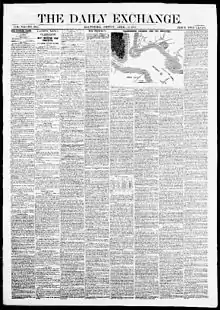The Daily Exchange
The Daily Exchange was a daily newspaper published in Baltimore, Maryland, United States from 1858 to 1861. It was originally owned and edited by Charles G. Kerr and Thomas Hall Jr. In 1859, Henry Fitzhugh, William Carpenter, and Frank Key Howard bought into the paper.[1] Howard soon headed the editorial staff and Severn Teackle Wallis contributed editorial columns frequently.[2]
 The front page of The Daily Exchange, April 12, 1861. | |
| Type | Daily newspaper |
|---|---|
| Format | Broadsheet |
| Founder(s) | Charles G. Kerr Thomas Hall Jr. |
| Opinion editor | Severn Teackle Wallis |
| Founded | 1858 |
| Political alignment | anti-Know-Nothing Party |
| Ceased publication | 1861 |
| Headquarters | Baltimore, Maryland |
It was a four-page paper and was published every morning except Sundays. The paper included news items; financial reports and editorials; political intelligence and editorials, claiming to “to preserve a position of honest and fearless independence;” reviews of literature and art; and advertisements.[3]
Background
In 1858, Baltimore was highly run by the mob, and the Exchange was highly critical of the Know-Nothing Party. Any businesses or political figures involved were viewed as corrupt. Following a series of threats to the editors, on August 12, 1858, the paper's office was broken into, and employees were assaulted and property was destroyed.[4] All of these tactics only served to increase the popularity of the Exchange.[5]
In 1860, the scope of the newspaper shifted to national politics and Kerr, Hall, and Fitzhugh sold their shares to William Wilkins Glenn,[6] who maintained ownership with Carpenter and Howard. The Exchange backed John C. Breckinridge in the 1860 presidential election and supported states' rights although not secession. Because of its anti-Lincoln administration views during the Civil War, the newspaper was suppressed by the government[5] and on September 10, 1861 finally banned from the U.S. Mail.[7] The next day the Exchange published an editorial of protest and Howard was arrested that night and Glenn was arrested a few days later.[2] Carpenter, who remained free, wrote a scathing editorial appearing on September 14, after which the government permanently suppressed the paper.[2]
Days later, two former employees of the Exchange, Edward F. Carter and William H. Neilson, began publishing the Maryland Times with Carpenter serving as editor.[2] The paper looked exactly like the Exchange and was discontinued on September 24, 1861.[2] The Maryland News Sheet replaced it and was published until August 14, 1862, when it was also suppressed by the government.[2]
Carter and Neilson then established the Baltimore Daily Gazette on October 7, 1862, and by 1865 ownership of the paper was returned to Glenn, Carpenter, and Howard.[2]
References
- "About The daily exchange. (Baltimore, Md.) 1858-1861 « Chronicling America « Library of Congress". Retrieved 27 January 2016.
- "Baltimore; its history and its people". archive.org. Retrieved 2016-05-02.
- ""Prospectus," Daily Exchange, February 22, 1858, p. 1". Retrieved 26 April 2016.
- "Daily Exchange, August 13, 1858, p. 2". Retrieved 26 April 2016.
- "History of Baltimore City and County, from the Earliest Period to the Present Day - Books on Google Play". Retrieved 27 January 2016.
- "Marks, Bayly Ellen, and Mark Norton Schatz. "Glenn, William Wilkins." In American National Biography Online". Retrieved 26 April 2016.
- "Daily Exchange, September 11, 1861, p.2". Retrieved 26 April 2016.
External links
- Newspaper page at Library of Congress Chronicling America project.